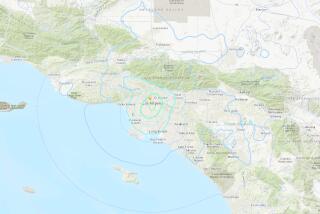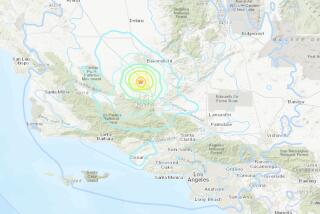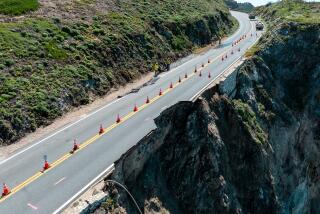EARTHQUAKE / THE LONG ROAD BACK : Truckers Get Goods Moving Again : Commerce: Drivers figure out alternate roads around closed freeways. Rerouting shipments may drive up price of produce.
- Share via
Shipments of fruit, gasoline, household furniture, clothing and other products moved fairly smoothly through the Southland on Tuesday, although the crippling of major freeways caused some delays while many damaged businesses couldn’t receive deliveries, transportation officials said.
Prices for fresh produce could rise later this year as the region becomes more dependent on shipments from the Central Valley, which may become more costly because of road closures, some officials warned.
As the Southland’s massive transportation network flexed its muscles for the first time following Monday’s devastating temblor, there were some delays reported as truckers scrambled for alternate routes and the region’s major railroads labored to restore service.
Union Pacific, Santa Fe and Southern Pacific railroads were all expected to resume full service by this afternoon, including Southern Pacific’s Coast Line route, which was closed when the earthquake derailed a 64-car freight train near the quake’s epicenter in Northridge.
Truckers, meanwhile, exchanged notes “via CB radio or face to face at truck stops . . . to determine the best way to navigate around and through the affected areas,” said Paula Riebe, a spokeswoman for Allied Van Lines.
Their biggest headache was the closure of Interstate 5 north of Los Angeles. The freeway is the main artery between Southern California and the central farming regions, Northern California and the Pacific Northwest.
The truckers’ option of choice appeared to be driving from the Los Angeles area east to San Bernardino, where they took Interstate 15 north over the Cajon Pass, joined U.S. 395 and then crossed back west over the Tehachapi Mountains to rejoin Interstate 5 or U.S. 99 near Bakersfield.
Atlantic Richfield Co., whose roughly 500 gasoline stations in greater Los Angeles are served by 45 delivery trucks that are loaded in South Gate, used that route for its deliveries to the Antelope Valley, said spokeswoman Annie Reutinger.
“We’re not even behind one load for the places that are open,” she said, noting that about 15 Arco stations remain closed because of quake damage, most in the San Fernando Valley. “The ones that are open are full.”
Still, the day presented a host of problems for truckers.
The challenge for the drivers and dispatchers at Qwikway Trucking Co. was to move a backlog of freight from Monday and maneuver around closed freeways and other obstacles.
“Everybody wants their deliveries first,” said Qwikway dispatcher Reyes M. Gonzales, who had to do without four big rig drivers whose homes had been damaged. “These are going to be trying times.”
Some of the Qwikway drivers who did show up at the company’s Vernon terminal were reluctant to travel to the San Fernando and Antelope valleys, where trucks faced long delays as a result of streets closures and the partial shut down of I-5. Gonzales had to cancel one shipment of fabric to a Lancaster cloth store after drivers refused to go.
“Forget about it. How are you going to get there?” one driver told Gonzales.
But overall, certain factors worked in favor of the shipping companies Tuesday--factors that probably won’t last long, some transport operators said.
For instance, they noted that traffic in general was light Tuesday, as many people eschewed work and many businesses stayed closed. Several grocery, mall and department stores were among those closed because of quake damage, reducing the demand for supplies shipped by truck.
Indeed, for Qwikway driver Jose Leon, 28, it was the closure of damaged businesses that gave him more problems than blocked freeways. Leon was able to make only five of 13 scheduled deliveries in West Los Angeles when he found stores and entire malls--including the Beverly Center, Westside Pavilion and Santa Monica Place--closed.
At Crenshaw Plaza, where the quake had knocked out the freight elevators and caused widespread damage, Leon and his helper, Raul Jaime, lugged boxes through water stained hallways and up a stairway to a Kinney Shoe store, where employees were repairing displays and merchandise that had been knocked over.
At Santa Monica Place, Leon brought his 24-foot-long Ford truck to an abrupt halt when he saw the loading dock was flooded. Dumpsters and debris floated in the black water.
“That’s it,” said Leon, who is paid based on completed deliveries. “Now, I’m really mad. I should have stayed home today.”
Produce deliveries, meanwhile, were aided by the fact that many crops currently sold in the Southland are shipped in from the Imperial and Coachella valleys and other points east and south that don’t run into the section of I-5 that’s closed, said Barbara Buck, executive vice president of the Fresh Produce & Floral Council in Los Angeles.
But once Southern California’s demand for crops from Central California rises this spring, the disruptions could result in higher prices and shortages, said Bill Garnett, president of Think Fresh Transport in Los Angeles, which uses its own fleet and outside truckers to deliver produce.
“You’re going to see some (price) fluctuations, depending on where the harvest is and the commodity,” Garnett said.
Using the alternate routes to travel north from Los Angeles add at least two hours to a trip to Central California and, in some cases, make the trip unprofitable for the trucker, Garnett said. That means truckers likely will have to charge the farmers and wholesalers more for some crops, and those additional costs could be passed on to consumers, he added.
In any case, just getting through Los Angeles’ city limits proved a challenge for United Parcel Service.
“We’re rerouting through surface streets where we can,” said spokesman Susan Rosenberg at the company’s Atlanta headquarters. UPS also was working out alternative drop-off and pickup points for customers who needed to tend to damaged property, she said.
And some Allied Van Lines drivers arrived in the Los Angeles area Monday and Tuesday only to find they couldn’t reach their customers to deliver or pick up their belongings. “They’re in the area, sort of in a holding pattern for the next couple of days,” said Allied’s Riebe.
Riebe said one Allied customer in Chatsworth--who was very close to the quake’s epicenter--was scheduled to have her goods picked up Monday for a move to Washington state. That’s now on hold.
However, Allied movers already had packed all of her belongings on Saturday. So while the woman’s neighbors sustained heavy property damage, Riebe said, “as best as we can tell none of her possessions were damaged because they were all packed.”
More to Read
Sign up for Essential California
The most important California stories and recommendations in your inbox every morning.
You may occasionally receive promotional content from the Los Angeles Times.











